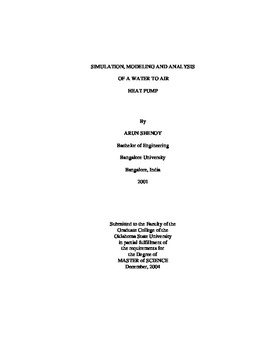| dc.contributor.author | Shenoy, Arun | |
| dc.date.accessioned | 2014-04-17T19:54:04Z | |
| dc.date.available | 2014-04-17T19:54:04Z | |
| dc.date.issued | 2004-12-01 | |
| dc.identifier.uri | https://hdl.handle.net/11244/10061 | |
| dc.description.abstract | The objective of the thesis is to develop a simplified model that can simulate a water to air ground source heat pump system and implement the model in EnergyPlus. The model which includes a ground loop configuration is significantly modified for implementation in the EnergyPlus program. Also, the model is extended to calculate sensible and latent capacity splits for the heat pump while operating in the cooling mode. The performance of the simplified model is compared with the parameter estimation water-to-air heat pump model (Jin 1999) to determine the usefulness of implementing a simple model. The simplified and the detailed models are compared in a case study and the results are summarized and analyzed. The performance data generated using the model is compared with the manufacturer's catalog data to check the validity of the simulation. A visual basic graphical user interface that generates performance coefficients from manufacture's data was also developed. The model was successfully implemented in EnergyPlus as a single component model which can switch between heating and cooling modes. The accuracy of model coefficients generated from two different heat pump manufacturers' catalog data was evaluated. This evaluation showed that for all cases, the error in the predicted results was less than 1.5%. The model has been validated for both the heating and the cooling modes. During the validation exercise, the model outputs were compared with the catalog data of the heat pump manufacturer. The comparison show a good agreement between the model predicted data and the calculated data. It was concluded that the model is useful to obtain sensible and latent capacity splits with good accuracy. A case study to check the performance of the heat pump model revealed that the models show the expected trends of the thermal processes correctly. For an annual simulation, the simplified model was 80% faster than the same input file with the detailed model. | |
| dc.format | application/pdf | |
| dc.language | en_US | |
| dc.publisher | Oklahoma State University | |
| dc.rights | Copyright is held by the author who has granted the Oklahoma State University Library the non-exclusive right to share this material in its institutional repository. Contact Digital Library Services at lib-dls@okstate.edu or 405-744-9161 for the permission policy on the use, reproduction or distribution of this material. | |
| dc.title | Simulation, Modeling and Analysis of a Water to Air Heat Pump | |
| dc.type | text | |
| osu.filename | Shenoy_okstate_0664M_1183.pdf | |
| osu.college | Engineering, Architecture, and Technology | |
| osu.accesstype | Open Access | |
| dc.description.department | Mechanical & Aerospace Engineering | |
| dc.type.genre | Thesis | |
